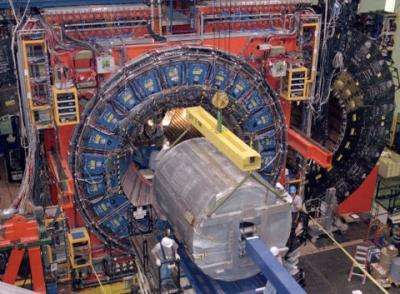The CDF detector at Fermilab. Credit: Fermilab.
(PhysOrg.com) -- A rumor that Fermilab’s Tevatron may have discovered evidence of a light Higgs boson wouldn't be the first unsupported speculation from Tommaso Dorigo, a physicist at the University of Padua in Italy, on his lively blog, but it is probably one of the most intriguing. Even a slight possibility that the world’s second largest accelerator has beaten the largest, the Large Hadron Collider (LHC), in finding the last particle in the Standard Model is enough to catch most people’s attention.
“It reached my ear, from two different, possibly independent sources, that an experiment at the Tevatron is about to release some evidence of a light Higgs boson signal,” Dorigo writes at his blog, A Quantum Diaries Survivor. “Some say a three-sigma effect, others do not make explicit claims but talk of a unexpected result. That the result comes from the Tevatron is for sure, since the LHC experiments do not have nearly enough data yet to search for that elusive particle, and other particle physics experiments in the world have not nearly enough energy to produce it. However, I am unable to understand whether the rumor comes from CDF or from D0 [Fermilab's two particle detectors].”
Both CDF and DZero have been collecting data for many years, and have been narrowing down the possible energies and masses at which a Higgs boson might appear. As Dorigo notes, last November, the two experiments jointly released an improved Higgs limit. With the additional data they’ve gathered since then (Dorigo estimates 50% more data), the scientists may have narrowed the limit even further. Last year, Fermilab physicists even predicted that they would have a 50% chance of detecting the Higgs by the end of this year.
In Dorigo’s blog post, the “three-sigma effect” refers to the statistical certainty of the result, corresponding to a 99.73% chance of it being correct. Generally, a three-sigma effect isn't classified as a true discovery; rather, a five-sigma (or 99.9999% chance of accuracy) is considered a high enough degree of certainty to be considered a fully acceptable discovery. Yet, three-sigma would still mean strong evidence of the existence of the Higgs. On the other hand, some physicists are hoping that the Higgs doesn’t actually exist, since this could provide clues to a theory beyond the Standard Model.
Dorigo is not part of the group(s) that may have discovered the Higgs evidence, and he is quick to admit that the rumor is pretty groundless right now. It seems that he just wants to share the excitement of the rumor he’s heard with the rest of the world. He adds that more news about the subject may be revealed by physicists later this month at the International Conference on High Energy Physics in Paris.
Tommaso Dorigo's blog post: "Rumors About A Light Higgs"
© 2010 PhysOrg.com






















